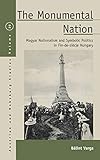The Monumental Nation : Magyar Nationalism and Symbolic Politics in Fin-de-siècle Hungary / Bálint Varga.
Material type: TextSeries: Austrian and Habsburg Studies ; 20Publisher: New York ; Oxford : Berghahn Books, [2016]Copyright date: ©2016Description: 1 online resource (300 p.)Content type:
TextSeries: Austrian and Habsburg Studies ; 20Publisher: New York ; Oxford : Berghahn Books, [2016]Copyright date: ©2016Description: 1 online resource (300 p.)Content type: - 9781785333132
- 9781785333149
- HISTORY / Europe / Austria & Hungary
- 19th century nationalism
- habsburg hungary
- historical study
- history
- hostility among provincial hungarians
- hungary
- impose unified national identity
- local and national memories
- massive project of cultural assimilation
- medieval conquest of carpathian basin
- moment hungarian nation was born
- quixotic episodes in magyarization
- resistance provoking
- study of magyarization
- online - DeGruyter
| Item type | Current library | Call number | URL | Status | Notes | Barcode | |
|---|---|---|---|---|---|---|---|
 eBook
eBook
|
Biblioteca "Angelicum" Pont. Univ. S.Tommaso d'Aquino Nuvola online | online - DeGruyter (Browse shelf(Opens below)) | Online access | Not for loan (Accesso limitato) | Accesso per gli utenti autorizzati / Access for authorized users | (dgr)9781785333149 |
Browsing Biblioteca "Angelicum" Pont. Univ. S.Tommaso d'Aquino shelves, Shelving location: Nuvola online Close shelf browser (Hides shelf browser)
Frontmatter -- Contents -- Illustrations and Tables -- Acknowledgments -- Terminology -- Abbreviations -- Introduction -- Part I A millennium-old past -- Chapter 1 The Challenge of Integration: Hungary in the Nineteenth Century -- Chapter 2 Anchoring a Millennium-Old Past in the Hungarian Minds -- Part II Cities -- Introduction -- Chapter 3 Pressburg and Theben -- Chapter 4 Nitra -- Chapter 5 Munkács -- Chapter 6 Brassó -- Chapter 7 The Magyar Inland: Pannonhalma and Pusztaszer -- Chapter 8 Semlin -- Chapter 9 Local Conditions of National Integration -- Part III Events -- Chapter 10 Prologue: The Many Faces of the Millennium -- Chapter 11 Signs for Eternity: The Millennial Monuments -- Chapter 12 The Millennial Monuments in the Public Space, 1896–1918 -- Appendix 1 Tables -- Appendix 2 Name Locator -- Bibliography -- Index
restricted access online access with authorization star
http://purl.org/coar/access_right/c_16ec
From the 1860s onward, Habsburg Hungary attempted a massive project of cultural assimilation to impose a unified national identity on its diverse populations. In one of the more quixotic episodes in this “Magyarization,” large monuments were erected near small towns commemorating the medieval conquest of the Carpathian Basin—supposedly, the moment when the Hungarian nation was born. This exactingly researched study recounts the troubled history of this plan, which—far from cultivating national pride—provoked resistance and even hostility among provincial Hungarians. Author Bálint Varga thus reframes the narrative of nineteenth-century nationalism, demonstrating the complex relationship between local and national memories.
Mode of access: Internet via World Wide Web.
In English.
Description based on online resource; title from PDF title page (publisher's Web site, viewed 25. Jun 2024)









